- Mon - Sat 8:00 - 6:30, Sunday - CLOSED
- support@soundproofhub.com
How to Soundproof a Gym: Stop the Noise & Protect Your Peace
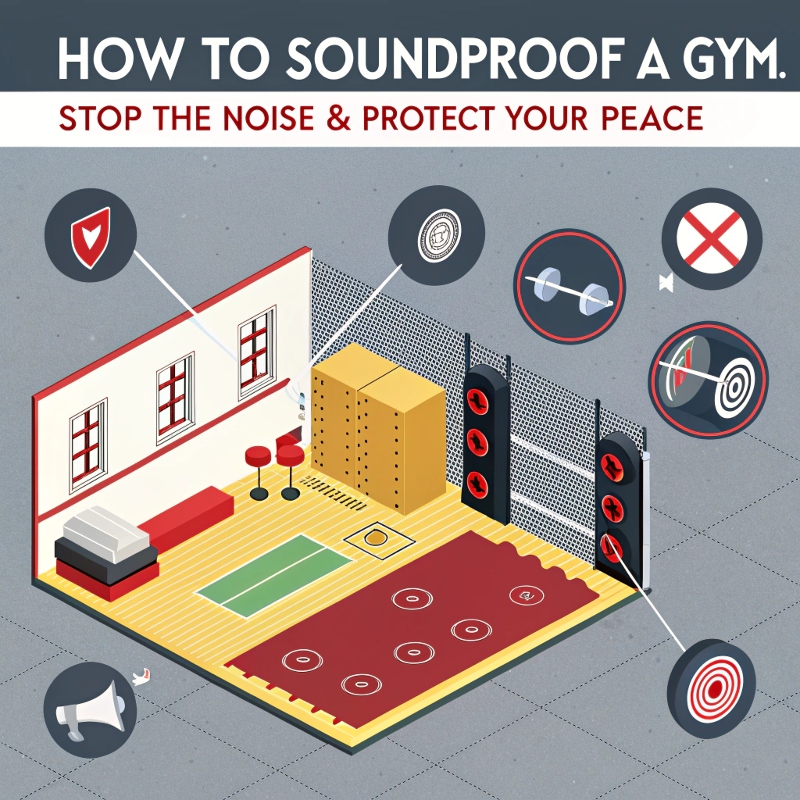
How to Soundproof a Gym: Stop the Noise & Protect Your Peace
The rhythmic thud of weights, the whir of treadmills, the beat of motivational music – these are the sounds of a thriving gym. But when that noise escapes, vibrating through walls and floors to disturb neighbors, residents, or other building occupants, it becomes a major problem.
Whether you’re a commercial gym owner facing complaints or a home fitness enthusiast trying not to wake the household at 5 AM, soundproofing a gym is essential. This guide breaks down effective strategies for both commercial gym soundproofing and creating a acoustic home gym.
Understanding the Gym Noise Problem: It’s Not Just Volume
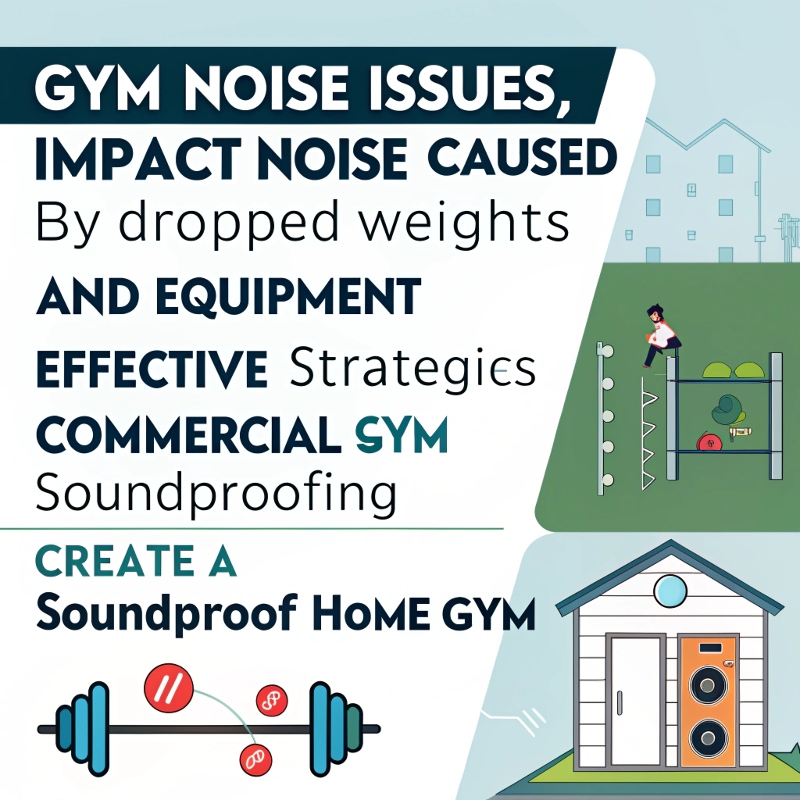
Before diving into solutions, understand the types of noise you’re battling:
-
Impact Noise: The biggest culprit. This is the energy transferred through structures when objects collide – think dropping weights, kettlebells, or heavy equipment. It creates vibrations that travel through floors, walls, and even ceilings.
-
Airborne Noise: Sound waves traveling through the air – music, shouting, grunting, equipment motors, and instructor voices.
-
Structure-Borne Vibration: The humming, buzzing, or rumbling transmitted through the building structure itself from heavy machinery like treadmills or ellipticals.
Effective gym soundproofing tackles all three, but impact noise is often the most disruptive externally.
Key Principles of Soundproofing: Mass, Decoupling, Damping, Absorption
-
Mass: Heavy materials block sound waves. Adding dense layers helps.
-
Decoupling: Preventing direct contact between structures stops vibrations from traveling. Creating an “air gap” or using resilient materials is key.
-
Damping: Converting sound energy into heat within materials, reducing vibration (especially crucial for impact noise).
-
Absorption: Trapping sound waves within the room (using soft, porous materials) reduces reverberation, making the space less noisy internally and slightly reducing what escapes. Note: Absorption helps internally but is NOT true soundproofing for blocking external noise transmission.
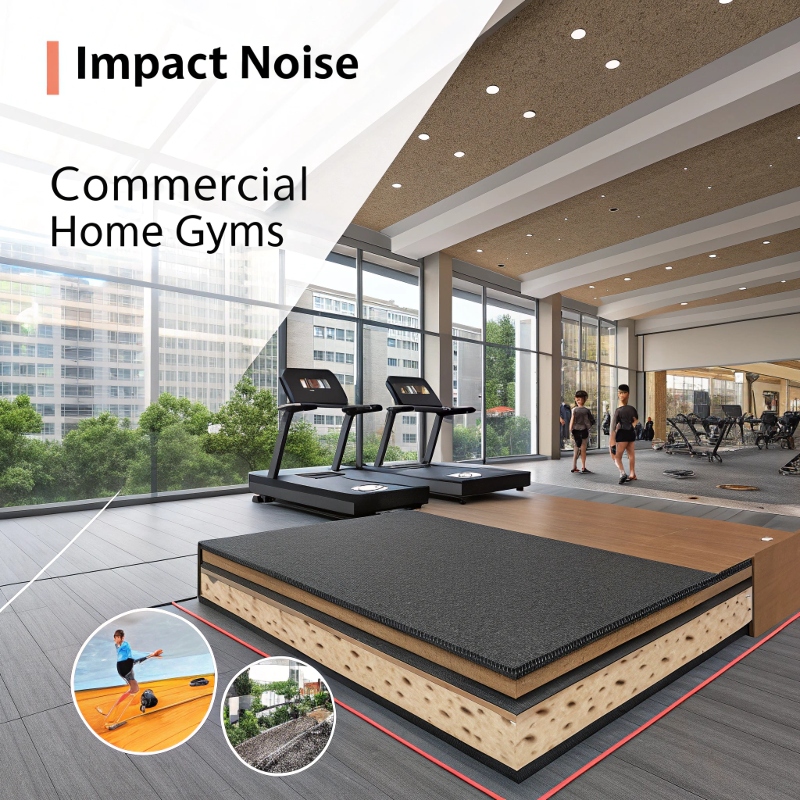
Effective Soundproofing Solutions for Your Gym
1. Target the Floor: Your First & Most Critical Defense (Especially for Impact Noise)
This is non-negotiable for stopping the “thud” felt below. Don’t confuse standard gym flooring with true soundproof gym flooring.
-
High-Density Rubber Flooring: The foundation. Opt for thick (at least 3/4″ or 19mm), high-density rubber mats or rolls. These provide mass and damping. Look for products specifically designed as gym mats for soundproofing or commercial rubber gym mats for soundproofing.
-
Floating Floors (The Gold Standard for Impact Noise): This involves decoupling the gym floor from the building structure.
-
Method: Install a layer of specialized acoustic underlayment (like recycled rubber, cork, or specialized foam composites) directly onto the subfloor. Then, build a new “floating” subfloor (usually plywood or OSB) on top without attaching it to the walls or the original subfloor. Finally, install your top layer of soundproof gym mats or rubber flooring on this new deck.
-
Why it Works: The underlayment absorbs and dampens the impact energy, while the air gap prevents vibrations from transferring directly to the building structure. This is essential for gym floor soundproofing in multi-story buildings or homes.
-
-
Layered Approach: Combine a floating floor system with thick, high-density rubber mats on top for maximum impact noise reduction.
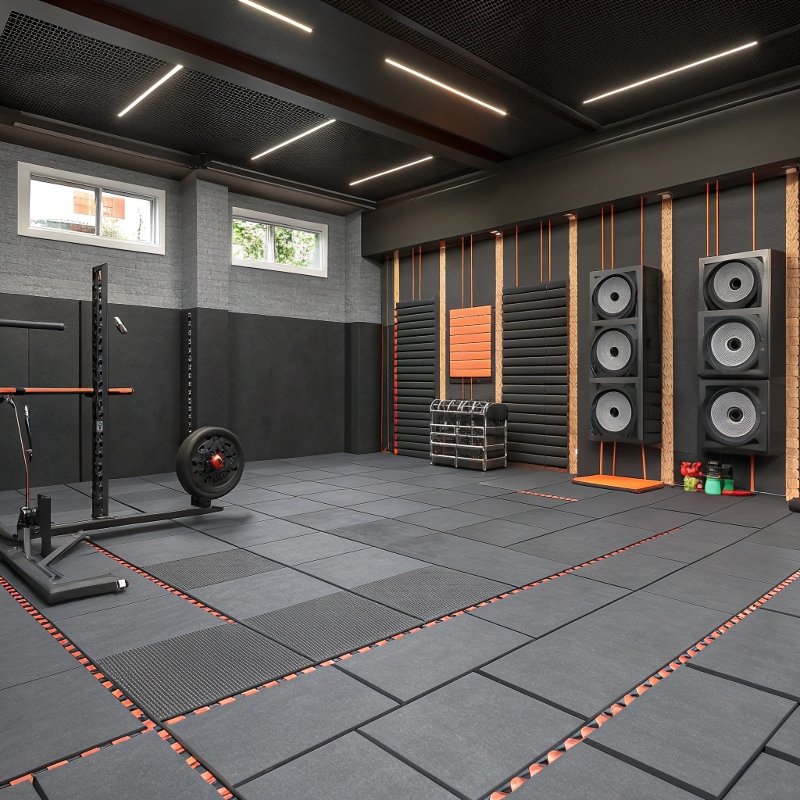
2. Soundproofing Walls: Containing the Roar
Walls transmit airborne noise and some impact vibration.
-
Add Mass & Decouple:
-
Resilient Channels: Attach metal channels horizontally to the studs. Then attach new drywall only to these channels. This decouples the drywall from the studs, breaking the vibration path. Fill the stud cavity with soundproof insulation (mineral wool is best).
-
Double Drywall with Green Glue: Add a second layer of drywall over the first (or over resilient channels). Apply a viscoelastic damping compound like Green Glue between the two layers. This compound converts sound energy into heat. Seal all edges with acoustic sealant.
-
Mass Loaded Vinyl (MLV): A heavy, flexible sheet. Can be added between drywall layers or under flooring for extra mass and damping. Effective but relatively expensive.
-
-
Seal EVERY Gap: Sound leaks like water. Use acoustic sealant (not standard caulk) around all perimeters – top, bottom, sides – of walls, electrical boxes, pipes, and ductwork penetrations. Install foam gaskets behind outlet and switch plates.
3. Soundproofing the Ceiling (Crucial for Lower Levels)
Protecting spaces below requires tackling the ceiling structure.
-
Decoupled Ceiling: Similar to walls. Use resilient channels or specialized isolation clips attached to the joists. Hang a new layer of drywall from these, creating an air gap. Fill the joist cavities with soundproof insulation (mineral wool).
-
Double Drywall with Green Glue: Apply the same double-layer + damping compound technique to the ceiling.
-
Acoustic Ceiling Tiles (Limited Use): While good for absorbing internal noise, standard ceiling tiles offer minimal soundproofing value against impact noise traveling through the structure. They don’t add significant mass or decoupling. Focus on the structure above the tiles.
4. Soundproofing Doors: The Weakest Link
A hollow-core door is useless for sound. Doors are major sound leaks.
-
Solid Core Doors: Replace hollow doors with solid wood or solid core doors. Much heavier = more mass.
-
Proper Sealing: Install high-quality acoustic door seals around the entire perimeter (top, sides, and an automatic drop-down seal or sweep on the bottom). The threshold must also be sealed.
-
Double Doors: Creating a small soundlock vestibule with two solid-core, well-sealed doors significantly improves isolation.
5. Addressing Equipment Vibration
-
Equipment Mats: Place heavy-duty soundproof gym mats or specialized vibration-damping pads under every piece of equipment – treadmills, ellipticals, weight machines, squat racks. These soundproofing floor mats for gym isolate vibrations.
-
Anti-Vibration Pads: Use specialized anti-vibration pads or mounts designed for specific heavy equipment.
Special Considerations:
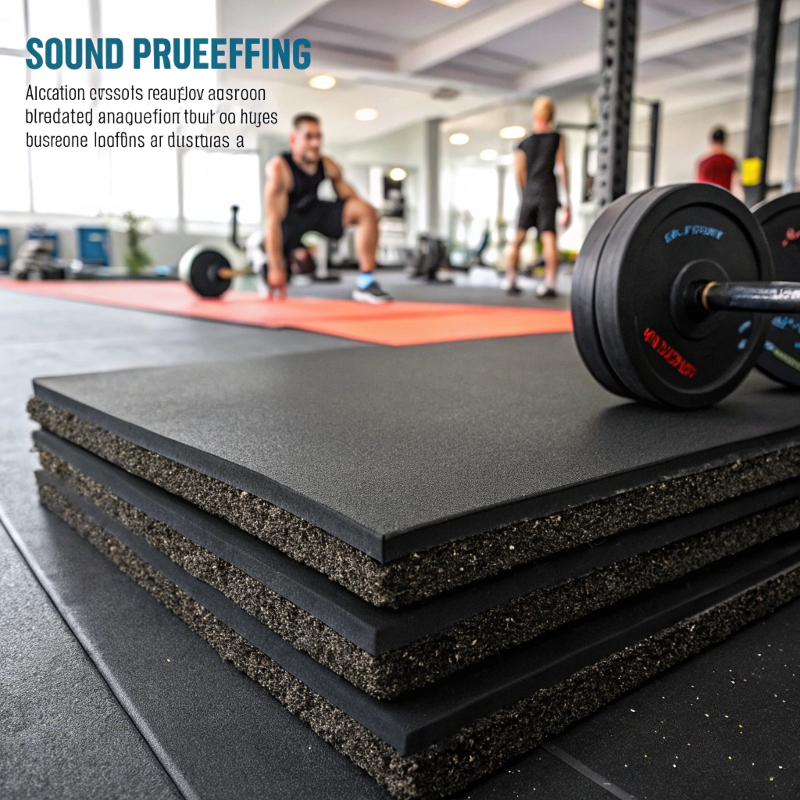
-
Soundproof Home Gym: The principles are the same, but scale and budget differ. Prioritize:
-
Floating Floor: Essential in garages (soundproof garage gym) or upstairs rooms.
-
Thick Rubber Mats: Heavy coverage over the entire workout area.
-
Sealing Gaps: Pay meticulous attention to doors, windows, and wall/floor/ceiling junctions.
-
Wall Treatment: Adding mass (extra drywall with Green Glue) and sealing is highly effective. Decoupling might be feasible on new builds or major renos.
-
Budget Tips: Layer existing flooring with thick rubber mats. Seal gaps ruthlessly. Use heavy moving blankets on walls as a temporary measure (not fire-safe long-term). Explore soundproof home gym cheaply options cautiously – prioritize effectiveness and safety.
-
Soundproof Garage Gym: Concrete slabs transmit impact noise well. A floating floor system is often the only effective solution for weightlifting. Seal the garage door as best as possible (specialized kits exist, but it’s challenging). Insulate and add mass to shared walls.
-
-
-
Commercial Gym Soundproofing: Requires professional assessment and implementation. Focus heavily on floating floors in weight areas, structural decoupling, high-STC (Sound Transmission Class) wall/ceiling assemblies, and specialized commercial gym mats for soundproofing. Soundproofing a CrossFit gym demands particularly robust floor solutions. Consider soundproofing in gyms as part of the core build-out, not an afterthought.
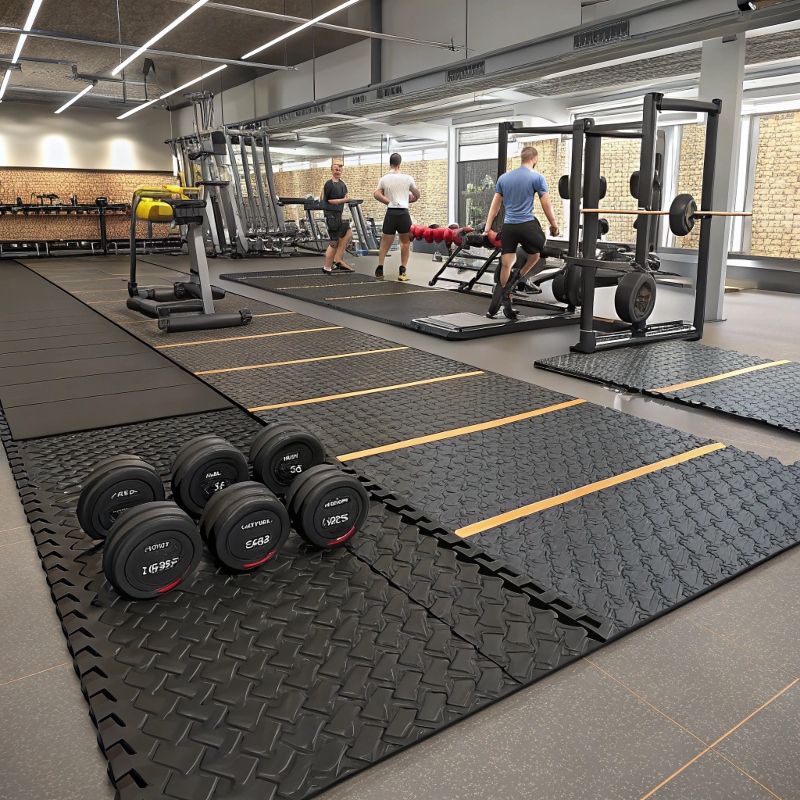
Conclusion: Peace Through Proven Methods
Achieving a truly soundproof gym – whether commercial or home-based – requires understanding the noise types and applying the core principles: mass, decoupling, damping, and sealing. Soundproofing a gym is an investment, but one that pays dividends in neighborly relations, member satisfaction (for commercial gyms), household peace (for home gyms), and avoiding costly complaints or legal issues.
Start by ruthlessly attacking the floor, especially for impact noise. Seal every possible gap. Add mass and decoupling to walls and ceilings where feasible. Don’t neglect doors and equipment vibration. By systematically implementing these strategies, you can transform your space from a noise nuisance into a contained powerhouse of fitness.
FAQ: Gym Soundproofing Answered
Q1: What’s the difference between soundproofing and sound absorption?
A: Soundproofing (Blocking) prevents sound from entering or leaving a space (stopping noise transfer to neighbors). Sound Absorption reduces echo and reverberation within a space (making it less noisy inside, using acoustic panels). You need both for an optimal gym environment, but they solve different problems. Soundproofing gym focuses on containment.
Q2: Will thick rubber mats alone soundproof my home gym floor?
A: Thick, high-density rubber gym mats are crucial for damping impact noise and protecting your floor, but they alone won’t fully soundproof against heavy weight drops, especially for downstairs neighbors. For significant impact noise, a full floating floor system is the most effective solution. Mats are essential but often part of a larger system.
Q3: How much does it cost to soundproof a gym?
A: Costs vary wildly. A soundproof home gym using mats and sealing might cost a few hundred to a couple thousand dollars. A basic garage gym floating floor could be $3-$8 per sq ft for materials. Full commercial gym soundproofing with decoupled walls/ceilings and professional installation can run tens of thousands to over $100k+, depending on size and methods. Prioritize based on your biggest noise issues and budget.
Q4: Can I soundproof an existing gym without major construction?
A: Significant improvements are possible, but true high-level soundproofing often requires construction. Focus on:
-
Maximizing thick soundproof gym flooring coverage.
-
Adding mass-loaded vinyl under existing mats (if possible).
-
Sealing EVERY gap meticulously.
-
Using anti-vibration pads under all equipment.
-
Installing solid-core, well-sealed doors.
-
Adding acoustic panels to walls/ceilings to reduce internal noise levels (which slightly helps what escapes).
Q5: What’s the best way to soundproof a garage gym for weightlifting?
A: The concrete slab is the main issue. Your best bet is a floating floor:
-
Lay down a high-quality acoustic underlayment designed for impact noise.
-
Build a plywood subfloor on top (not attached to walls).
-
Cover entirely with thick (3/4″ or more), high-density soundproof gym mats or rubber tiles. Also, insulate and add mass to any shared house walls, and seal the garage door as best you can.
Q6: Are “soundproofing” gym mats different from regular gym mats?
A: Sometimes. While all thick rubber mats help dampen sound, mats specifically marketed for soundproofing or as soundproof gym mats often have higher density or specific compositions designed for superior impact noise reduction. Look for mats emphasizing acoustic properties or IIC (Impact Insulation Class) ratings. Commercial rubber gym mats for soundproofing will typically meet higher standards.
Q7: Is it possible to fully soundproof a gym?
A: Achieving absolute silence transmission is extremely difficult and expensive. The goal of soundproofing a gym is to reduce noise transmission to acceptable levels, compliant with local building codes or sufficient to prevent disturbances to neighbors. How to fully soundproof a gym involves comprehensive application of all principles: massive decoupled walls/ceilings, floating floors, expert sealing, and specialized doors/windows. Significant reduction is very achievable.
2 COMMENTS
Hip Hop
As someone who is just beginning to explore this particular domain, your post made the foundational concepts incredibly easy to grasp. Your focus on clear explanations, free of unnecessary jargon, was immensely helpful for a newcomer.
saranya
I like the efforts you have put in this, regards for all the great content.




Muhammad Zeeshan
Muhammad Zeeshan is an SEO expert specializing in link building (SaaS, Tech, Business, and Home Improvements). I am very passionate about search engine optimization, backlink building, and guest blogging. I can help you in attracting a new audience and in achieving a higher rating.